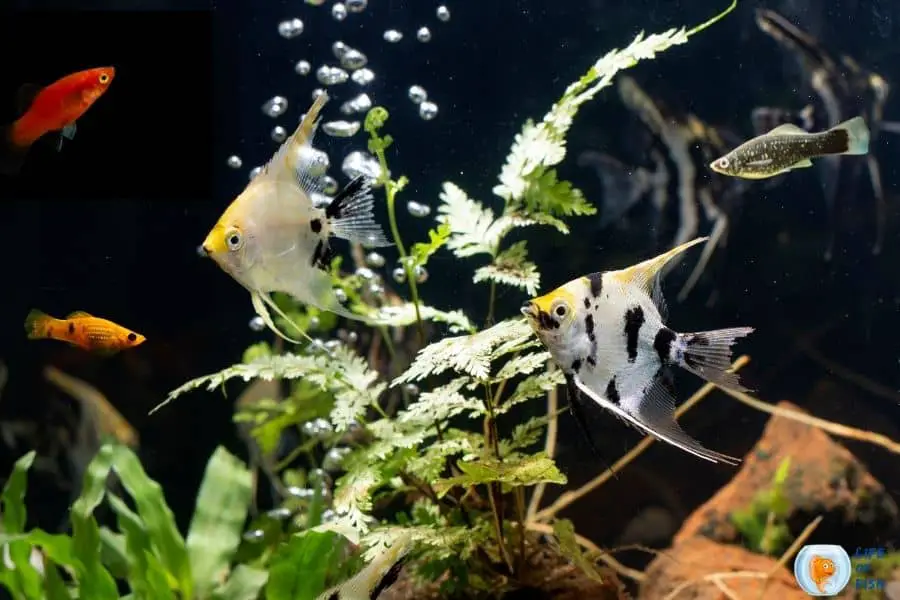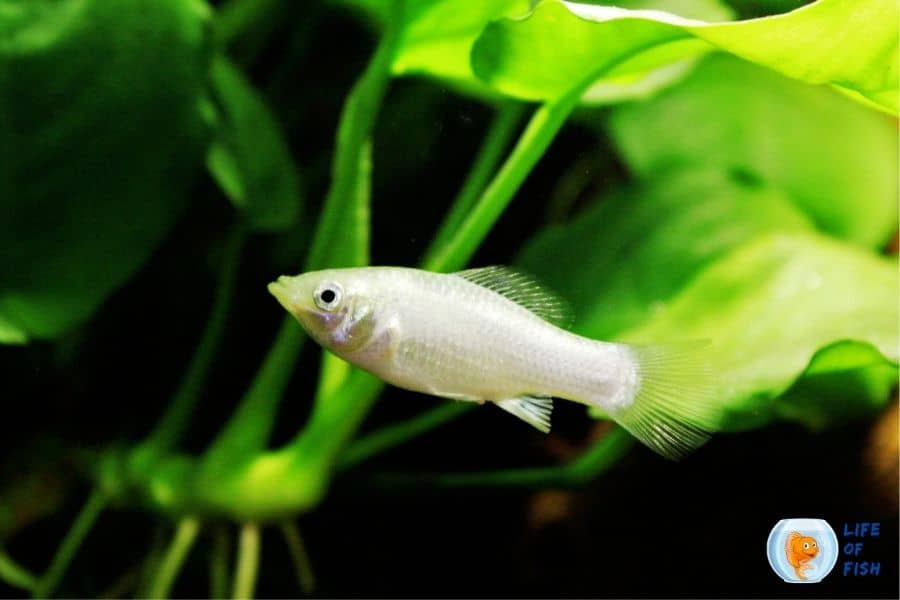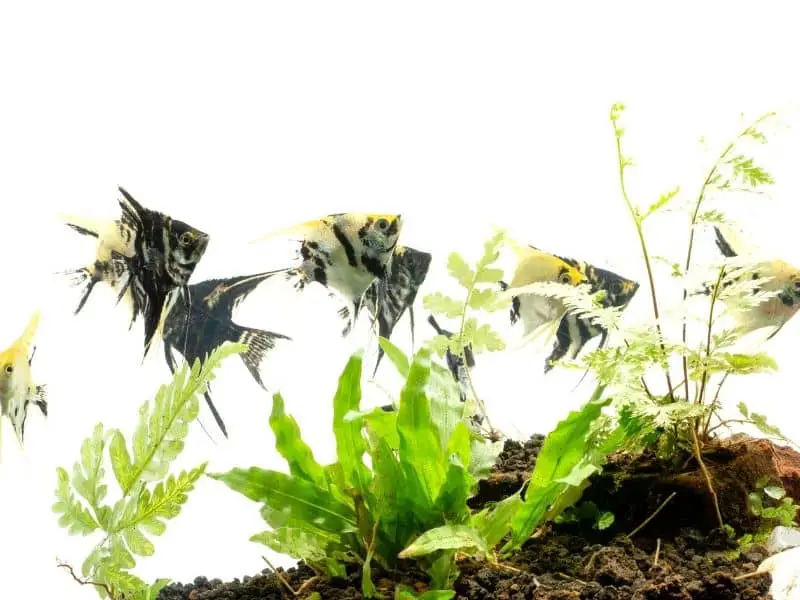Can angelfish live with mollies? You might be surprised that they actually can. Mollies may be easy prey for angelfish. Still, angelfish have fewer conflicts with mollies.
Why is that? Let’s find out.

Cichlids are known to eat smaller fish when given a chance. And they are aggressive toward their tank mates, making them unsuitable for peaceful community tanks. Since Angelfish is a cichlid, many aquarists expect the same from angelfish.
But the truth is otherwise. Although angelfish are aggressive, they are relatively peaceful species that can cohabit well with most other fish (at least more than other cichlids).
What kind of fish can live with angelfish?
Jump To
Angelfish are semi-aggressive fish that have a relatively calm temperament. This means they do not bother other fish as much as other cichlids would.
That being said, angelfish are not the best community tank fish. They are still prone to nipping the fins of other fish and can be a bully to smaller, more delicate fish.
The best tank mates for angelfish are fish that are of a similar size, are not too delicate, and can handle themselves in a fight. Good examples of such fish are:
- Tetras
- Gouramis
- Danios
- Barbs
Can angelfish live with mollies?
As surprising as it may be, angelfish can live with mollies. Mollies are not as delicate as other fish and can actually hold their own against an angelfish.
Many aquarists have nicknamed mollies as the chameleons of aquariums because they can get along well with most other fish and adapt to a wide range of water conditions.
Therefore, mollies can also withstand the water conditions that angelfish are comfortable with.
Mollies can defend themselves
Mollies are also a good size for angelfish. They are not too small that they will be eaten by the angelfish and not too large that they will bully the angelfish.
On the other hand, Angelfish can not bully mollies because mollies can defend themselves. Angelfish usually do not bother mollies unless they are hungry.
But mollies are fin nippers
The only problem you might have with keeping angelfish and mollies together is that mollies are known to nip fins. Since angelfish have long and beautiful fins, they are prone to be nipped by mollies.
Still, angelfish can defend themselves if mollies get too aggressive. In most cases, the fins of angelfish will grow back.
However, if you see that the mollies are constantly nipping your Angelfish, it is best to separate them.
They are territorial
The reason for this aggression toward other species is that both species are territorial. They do not prefer to share their space with other fish.
So, when they are put in a tank together, they will try to establish their own territory.
Still, they can coexist well
The good news is that, as long as the tank is big enough, they will eventually learn to coexist and won’t bother each other much.
The best way to reduce the aggression is to provide plenty of hiding spots and plants in the tank so each fish can have their own space.
You can avoid most conflicts when you provide ideal conditions in your tank for both species, such as giving them large enough space to coexist together.
To better understand the needs of mollies and angelfish, let’s discuss the characteristics and requirements of mollies and angelfish.

Characteristics and requirements of mollies and angelfish
Each fish species have its own unique characteristics and requirements. To provide ideal conditions for both species, you need to understand these characteristics and requirements.
Temperament
Different fish have different temperaments. Some are peaceful, while others are aggressive.
Some fish species have temperaments in between them. Fish enthusiasts name them semi-aggressive fish.
It is essential to know these dissimilarities if you are a fish keeper, as it will help you when you are stocking your aquarium.
Mollies are considered peaceful fish, while angelfish are semi-aggressive. However, both species can be aggressive when they are protecting their fry or when they are establishing their territories.
Although mollies are peaceful, they will become aggressive (or should we say defensive) when being attacked by another fish.
The same is true for angelfish. However, when left alone, both species will mind their own business, not attack each other.
Both species need to have plenty of space to establish their territory in the tank. If given much space and plenty of hiding places, they will eventually stop being territorial and start coexisting with each other.
Size
The size of a fish is also an important consideration, especially when stocking your aquarium. The size of the fish will determine how big your tank should be.
It is important to know that different species grow at different rates. Some fish quickly grow while others grow slowly.
The size of an adult molly is about 3-4 inches (7.5-10 cm), whereas the size of an adult angelfish is about 6-8 inches (15-20 cm).
As you can see, angelfish are much bigger than mollies. That is why you need to provide a larger tank if you want to keep both species together.
The recommended tank size for keeping angelfish is at least 50 gallons. For mollies, the recommended tank size is at least 20 gallons.
If you want to keep both angelfish and mollies together, the recommended tank size is at least 70 gallons.
Diet
A fish’s diet is also a significant element to consider. Different fish eat different things. Some fish are herbivores, while others are carnivores. It is important to know what to feed your fish so they can stay healthy.
Mollies are omnivores which means they eat both plants and animals. In the wild, they eat algae, small crustaceans, and zooplankton. In the aquarium, they will eat almost anything you give them. They are not picky eaters.
Angelfish are also omnivores. However, they have a tendency to be carnivores. In the wild, they eat small insects, crustaceans, and zooplankton.
In the aquarium, they will also eat almost anything you give them. However, they prefer meatier food than mollies. You can feed them brine shrimp, tubifex worms, and bloodworms.
Nonetheless, it is important to provide a varied diet for both species. They need to balance plant and animal matter in their diet.
You can feed them pellets, flakes, and live/frozen foods. If you choose to feed your fish pellets or flakes, make sure they are protein-rich food.
Water Conditions
Water condition is also an important element to consider. Different fish come from different water conditions.
Some fish can adapt to a variety of water conditions, while others are very sensitive to changes in water conditions.
Mollies are very adaptable fish. They can live in freshwater or saltwater. In the wild, they are found in brackish water.
In the aquarium, they can live in a wide range of water conditions. The only thing you want to consider is the salinity level of the water.
Angelfish are also very adaptable fish. They can live in freshwater or saltwater. However, they are not as tolerant to changes in water conditions as mollies.
They prefer neutral to slightly alkaline water with a temperature of 75-82 degrees Fahrenheit.
If you want to keep both mollies and angelfish together, it is recommended to maintain neutral to slightly alkaline water with 75-82 degrees Fahrenheit temperature.
Tank setup
Tank setup can change according to each fish species because different fish are used to living in different habitats.
In the case of mollie, they live in shallow areas of streams and rivers with plenty of plants. Therefore, it is important to provide these conditions in your tank.
You should provide a sandy substrate to make things comfortable for mollies. Also, add plenty of plants so that mollies can rest, hide and reproduce. You can use live plants or fake plants.
Since the natural habitats of mollies have slow-moving waters, the waters in your fish tank should be similarly slow-moving. You can achieve this by adding a bubbler to your tank.
Angelfish come from rivers in South America. They live in areas with plenty of plants and hiding places in the wild.
They also prefer slow-moving waters. The waters of angelfish have low to no salinity levels, which is why they are mostly found in freshwater rivers.
When setting up a tank for angelfish, you should provide a sandy substrate. This is because the substrate should be soft as Angelfish are known diggers.
Add plenty of plants and hiding places for the fish. You can use live plants or fake plants.
Since angelfish come from rivers in South America, the water should be warmer than most other fish. The recommended temperature is 75-82 degrees Fahrenheit.
You should also maintain low to no salinity levels in the water. You can achieve this by using a freshwater aquarium.
If you want to keep both species together, it is recommended to maintain Angelfish water conditions since mollies can adapt well to these water conditions.
Be sure to provide a large enough tank to accommodate plants, decorations, other equipment, and your fish.

Reproduction
Angelfish and mollie have different reproduction techniques.
Mollies are livebearers, which means that they give birth to live young. The female molly will store the sperm of the male in her uterus, and when the fry is ready to be born, they will be expelled through the vent.
A single female molly can give birth to anywhere between 20 to 100 fry at a time.
Laying eggs
Angelfish lay eggs, and they can lay about 100 to 1000 at a time. The female will lay the eggs on a flat surface (usually the substrate), and the male will fertilize them.
Once the eggs are fertilized, the parents will mouth brood them. This means they will carry the eggs in their mouths until they hatch.
After the fry hatch, the parents will continue to mouth brood them for a few more days until they are able to fend for themselves.
Mating
When it comes to reproduction, mollies are easier to breed than angelfish as they reproduce rapidly in any water condition that allows them to live healthily.
On the other hand, angelfish require their ideal water conditions to reproduce. However, no conditioning is needed for both species.
Both fish species become aggressive when they are spawning. Therefore, it is important to provide plenty of hiding places for the other fish in the tank to escape the aggression.
Once the eggs are laid or the fry is born, it is best to remove the molly parents from the tank so that they do not eat their own young.
In the case of Angelfish, you do not have to do anything as the parents protect their young. However, the parents will attack other fish in the tank, so it is important to provide hiding places.
When it comes to breeding, mollies can be a headache as they reproduce rapidly. Unless you have a massive tank, it is best to remove the fry into a separate tank and sell them off.
Otherwise, the waste of the fry will pollute the water and affect the health of your other fish.
On the other hand, Angelfish are not as big of a problem when they breed. This is because they lay fewer eggs, and the parents will take care of the fry.
The angelfish fry can be left in the main tank until they are big enough to be sold or given away.
How to keep mollies and angelfish together?
Now that you know the characteristics and requirements of both fish species let’s summarize them so that you can easily remember how to keep them together in one tank.
- Provide a large tank of at least 70 gallons for both fish to live happily.
- Tank water condition should satisfy the angelfish. This is because mollies can adapt to angelfish water conditions, but not the other way around.
- Set the temperature to 75-82 degrees Fahrenheit and maintain low to no salinity levels.
- The ph level should be between 6.8 to 7.2.
- Ensure that there is plenty of hiding places for the fish as they become aggressive when spawning.
- Many aquarium plants are recommended as they help maintain water quality and provide hiding places.
- Provide a soft sandy substrate.
- Do not overcrowd the tank, as this will lead to stress and aggression.
- Feed protein-rich food along with live or frozen food and vegetables for variety.
- Water flow should be minimum for both species.
- An excellent filtration system is needed as mollies are messy eaters.
- When introducing both species, add mollies first to the tank. Then add angelfish as angelfish are more aggressive than mollies.
Conclusion
Both Angelfish and mollies are beautiful fish that make a great addition to any freshwater tank.
Angelfish and mollies can live together when it comes to compatibility if the right tank conditions are met.
They can also be bred together, but it is best to remove the fry into a separate tank as they will pollute the water quickly. Overall, they are a great combination for any freshwater tank.
Read Next : How To Tell If A Molly Fish Is Dying | 9 Signs |
